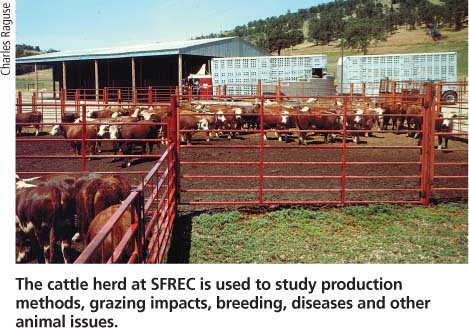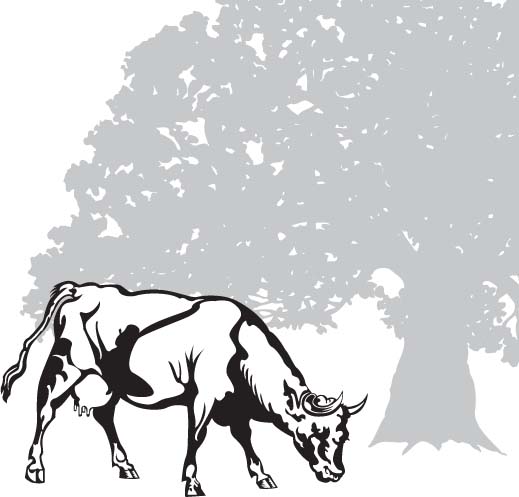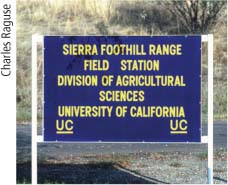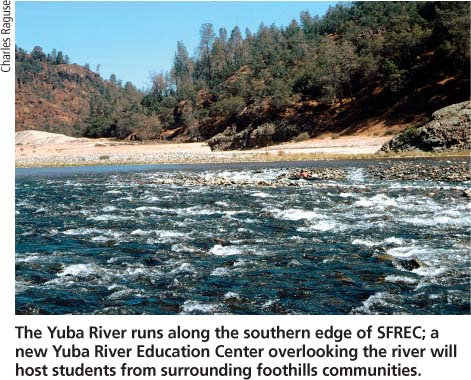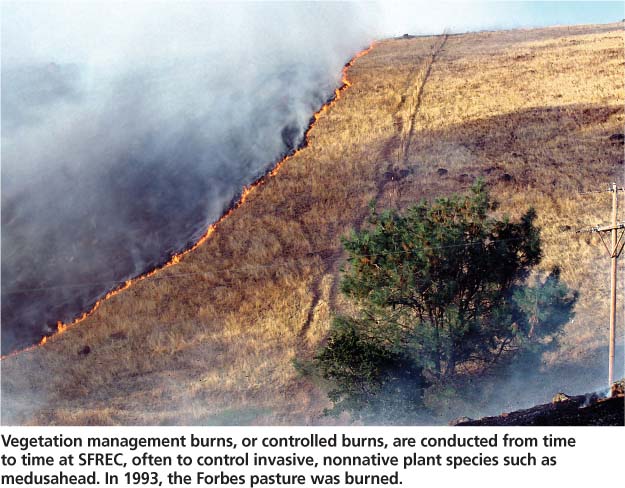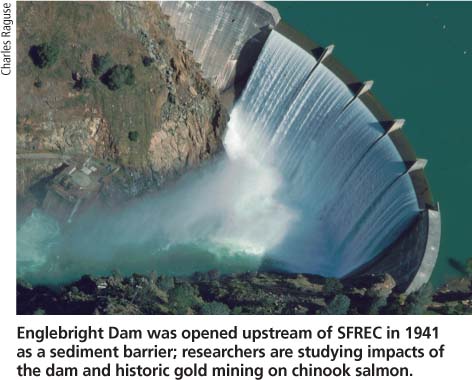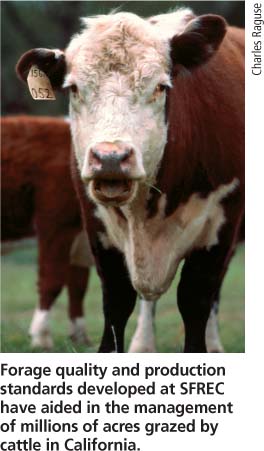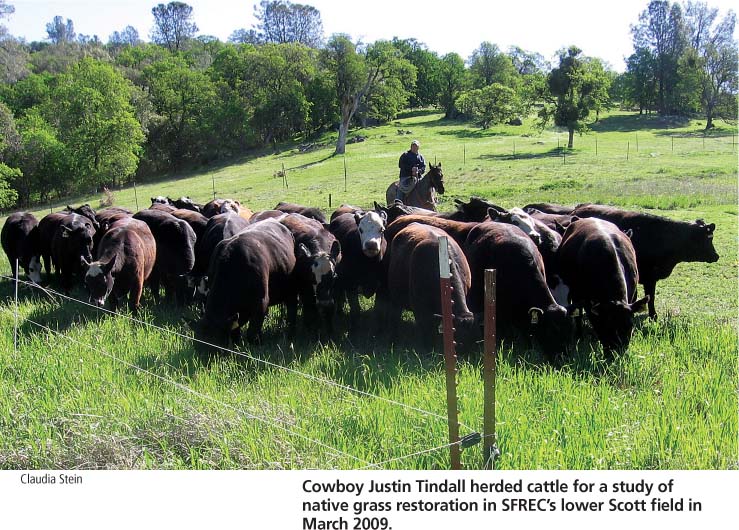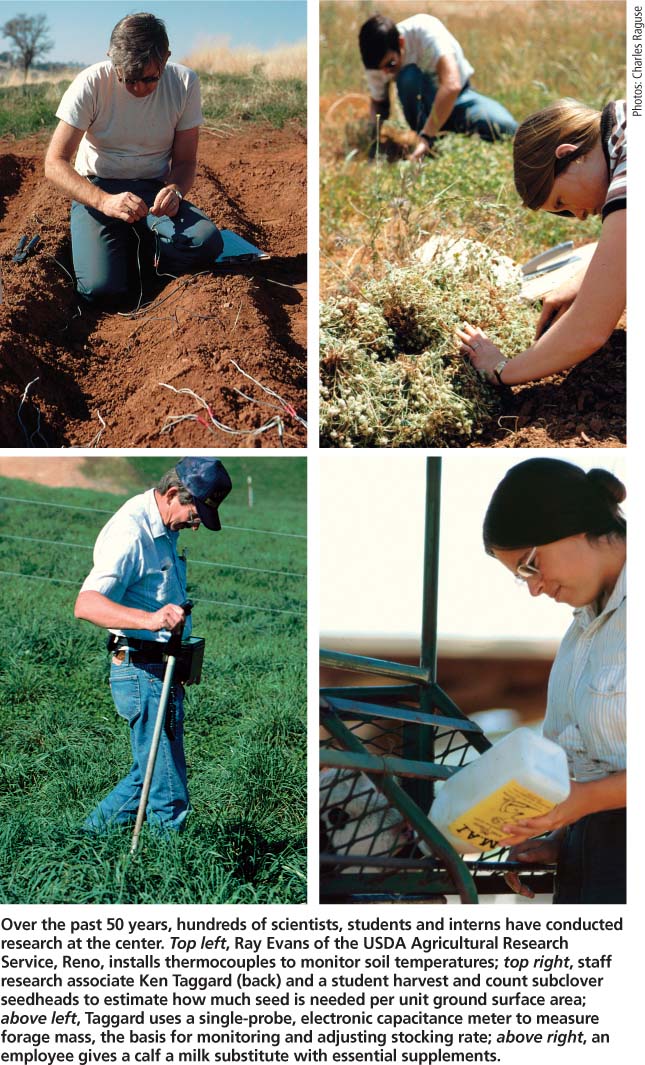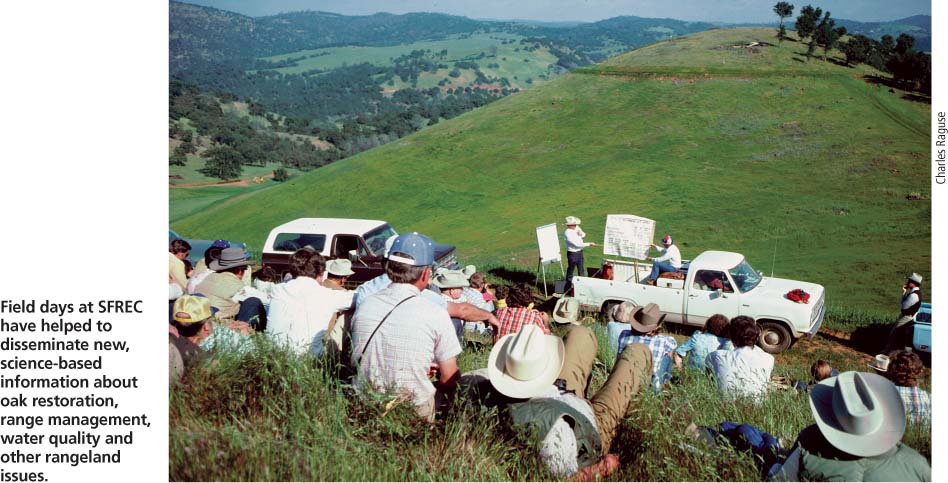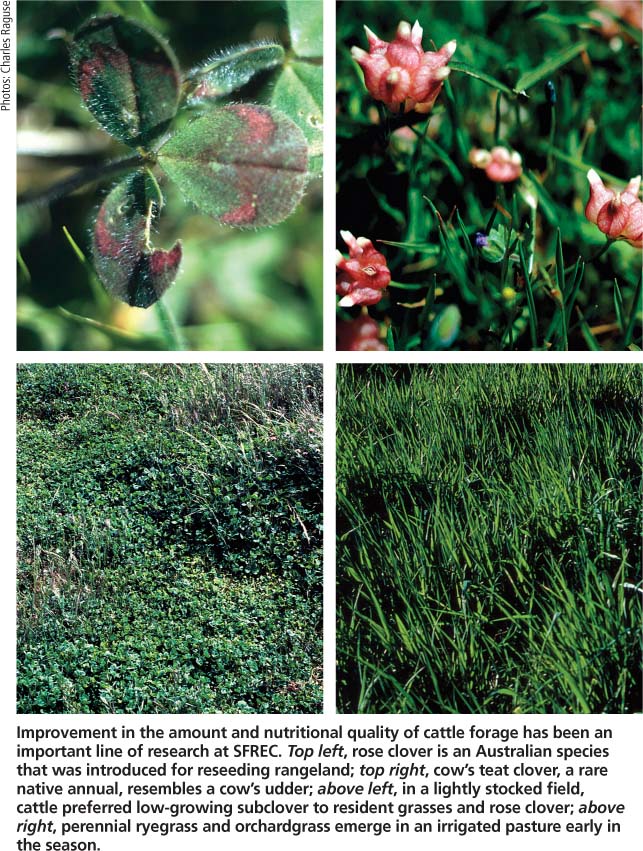All Issues
Sierra foothills research center celebrates 50 years of rangeland productivity
Publication Information
California Agriculture 64(2):57-62.
Published April 01, 2010
PDF | Citation | Permissions
Full text
When the UC Sierra Foothill Research and Extension Center (SFREC) was established in Yuba County in 1960, much of the focus was on increasing cattle production by improving forage. Now, as the center celebrates its 50th anniversary, its mission has expanded beyond rangeland productivity to emphasize natural resource protection and restoration.
“We want everything from rangelands all at once,” says UC Davis rangeland watershed specialist Kenneth Tate. “Society expects us to graze economically, control weeds, conserve native species, produce clean water and sequester carbon.”
The cattle herd at SFREC is used to study production methods, grazing impacts, breeding, diseases and other animal issues.
Rangeland benefits
SFREC is the youngest of the nine UC centers that facilitate research and outreach in climatic and agricultural regions statewide. The 5,700-acre center, located in Browns Valley about 60 miles northeast of Sacramento, typifies California's foothill rangelands, with its mix of oak and annual grass rangelands and terrain that extends from about 200 to more than 2,000 feet above sea level.
“It's the perfect place for field work,” says Tate, chair of the SFREC Research Advisory Committee. “It's large enough to support management-scale research, has a diversity of natural resources and has a sizeable cow herd that allows us to study grazing scenarios.”
Occupying more than half of the land statewide, California's 57 million acres of rangelands provide considerable economic and environmental benefits. Nearly half of this acreage is privately owned and provides forage for nearly all of the state's cattle and calves, California's 6th-largest agricultural commodity with a value approaching $1.8 billion in 2009.
Rangelands are also key to water quality and biodiversity. Because most of the state's major drainage basins are in rangelands, almost all of the surface water passes through them. The state's 10 million acres of hardwood rangelands, or oak woodlands, provide a host of ecosystem services from protecting watersheds to improving water quality to sequestering carbon. Oak woodlands are also home to the greatest diversity of plants and animals of any major habitat in California, with about 2,000 species of plants, 4,000 insects, 60 amphibians and reptiles, 170 birds and 100 mammals. SFREC research on the California black rail has led to recommendations for managing this rare marsh bird's habitat in irrigated wetlands of the Sierra foothills (see page 85).
But these economic and environmental benefits are threatened by demand for housing and other land uses, which has made the western foothills of the Sierra Nevada among the most rapidly developed regions statewide. “The recent development boom has decreased and fragmented our rangelands,” Tate says. “We need to conserve what's left.”
Cattle productivity and health
SFREC's five decades of research include work on cattle breeding (see page 106), nutrition (see page 101) and health that have helped boost beef productivity on foothill rangelands. Early findings contributed to establishing today's common practices of crossbreeding cattle, which has advantages such as hybrid vigor, and of calving in the fall rather than the spring, which has advantages such as decreasing calf diseases. Nutrition work includes studies showing how to supplement feed when the range forage is dormant as well as how to supplement selenium and copper, essential nutrients that are deficient in many foothill soils.
Health research includes studies showing that epizootic bovine abortion, or foothill abortion, is
caused by bacteria transmitted by the Pajaroello tick. “After 40 years of work, we're finally getting close to a foothill abortion vaccine,” says Michael Connor, director of the center from 1983 to 2005, adding that SFREC researchers are also working on a vaccine for pinkeye.“[SFREC is] the perfect place for field work. It's large enough to support management-scale research, has a diversity of natural resources and has a sizeable cow herd that allows us to study grazing scenarios.” — Ken Tate
May 1960 Ken Wagnon and Phil “Bub” Wright move 48 cows owned by UC from the U.S. Forest Service San Joaquin Range to Sierra Field Station.
1960s “Rangeland improvement” projects undertaken to remove native oaks and brush, and plant grass and legume species for forage.
Another current project is tracking cattle via electronic identification (EID) (see page 94). “It's very cutting edge,” says Arthur Craigmill, director of the center since 2006. “EID traces them from birth to carcass.” This can help improve meat quality and increase food safety by, for example, preventing or controlling disease outbreaks or microbial contamination.
Improving forage
In SFREC's first decades, much of the rangeland research focused on increasing forage productivity. “They initially tried to improve rangelands by removing oaks and introducing new forage species,” Connor says. This included cutting down oaks and using herbicides to keep the stumps from resprouting, using fire and herbicides to control brush, seeding with subterranean and rose clover, and then fertilizing these nutritious and palatable forbs.
In the 1980s, Connor began collecting forage productivity data that contributed to establishing a
The Yuba River runs along the southern edge of SFREC; a new Yuba River Education Center overlooking the river will host students from surrounding foothills communities.
Vegetation management burns, or controlled burns, are conducted from time to time at SFREC, often to control invasive, nonnative plant species such as medusahead. In 1993, the Forbes pasture was burned.
SFREC's three decades of forage productivity data also helped ranchers secure federal drought assistance in 2008. “We had the data to show that it was a bad year,” says SFREC director Craigmill, adding that long-term data collection and research are among the center's greatest benefits to Californians. “There are very few places where you can do this.”
Watersheds and ecosystem services
SFREC also has some of the state's longest-term data on watersheds. “Water quality really took legs in the late 1990s, as California as a whole began looking at improving waterways,” Connor says.
This work includes studies on how water quality is affected by grazing and prescribed fire, two of the most effective and economical ways of managing rangeland vegetation. The primary water quality concerns on these rangelands are nutrients, sediment and animal-borne microbial pollutants such as fecal coliforms, a group of bacteria that indicate fecal contamination, and Crytosporidium parvum, a pathogenic parasite that spreads in feces and water.
Englebright Dam was opened upstream of SFREC in 1941 as a sediment barrier; researchers are studying impacts of the dam and historic gold mining on chinook salmon.
1964 Scott Ranch property acquired from Marty family, creating one contiguous, 5,721-acre field station.
1969 First range improvement results published by Burgess L. (Bud) Kay of UC Davis; research by Jim Young and Ray Evans of USDA, Charles Raguse of UC Davis, and others follows.
1972 Results of first range beef management research, by Wagnon and UC Davis colleagues published; research by Roy Hull, Rick Delmas, Charles Wilson, John Dunbar and others follows.
Mid 1970s Field days established in April to share station research with land managers, scientist and neighbors.
Notably, SFREC studies by Tate and other UC researchers on pathogen transport in watersheds led to best management practices for vegetative buffer zones along streams and grazed areas that are used statewide today. Other findings include that moderate grazing, which meets RDM standards, and low-intensity prescribed fire have had minimal impact on water quality at the center. A comparison of ungrazed, moderate and heavy grazing showed that only the latter affected water quality significantly, by increasing fecal coliforms and nitrates.
The latest long-term watershed study will address how grazing affects multiple resources simultaneously. “Most research has been piecemeal, looking at the effect of grazing on a single resource such as water quality,” UC Davis's Tate says. “We're taking an integrative, holistic look at watershed responses to grazing.”
The team will evaluate how grazing affects a range of ecosystem services including forage production, water quality, biodiversity restoration, invasive weed resistance and soil carbon retention. These ecosystem services are also affected by soil properties, and recent work by UC researchers shows that the chemical and physical properties of SFREC soils can be extremely variable over short distances (see page 78).
“Ranchers are interested in conserving habitat and native species but they also have to make a profit, so we need to address both the conservation and economic aspects of grazing,” Tate says.
Protecting rangelands from overgrazing
SFREC studies have tested and extended standards for safe grazing and stocking rates — called residual dry matter or RDM — that optimize forage quality and production, and protect soil from erosion and nutrient loss. RDM is rooted in observations from the 1930s and 1940s that the amount of dry vegetation left in the fall affects the next growing season's forage in California rangelands.
Used to manage grazing intensity in California for about 30 years, RDM has been widely adopted by local, state and federal land-management agencies including the Bureau of Land Management, the Forest Service and the National Park Service. This safe grazing standard has also contributed to more efficient rangeland valuation.
“Grazing capacity is a major factor in rangeland values,” says UC Berkeley rangeland ecologist James Bartolome, lead author of the RDM guidelines.
This is particularly true for land dedicated to agriculture under the 1965 Williamson Act, which benefits ranchers by basing taxes on farming use rather than on market value. By combining RDM with remote-sensing data and geographic information systems (GIS), UC researchers helped save millions of dollars in tax assessments of Williamson Act rangelands in San Joaquin Valley foothill counties.
RDM guidelines vary with factors such as rainfall and terrain, and in 1991 a scorecard was developed for estimating grazing capacity based on rainfall, slope and canopy cover. “It worked well when people tried it but there was little research to back it up,” Bartolome says, adding that the initial standards were based largely on the study of nine sites around the state with variations in rainfall. “We reevaluated the data and identified gaps,” he says. “The sites were all flat grasslands so we decided to see if RDM was affected by slope, aspect and woody cover.”
Forage quality and production standards developed at SFREC have aided in the management of millions of acres grazed by cattle in California.
To find out, Bartolome began studies on de-oaked hills at SFREC in the late 1990s. “Surprisingly, slope and aspect had little effect,” he says. This work was incorporated into the latest RDM guidelines, which were set in 2006 and vary according to land type, from dry annual grassland to annual grassland/hardwood range to coastal prairie.
To see how woody cover affects RDM recommendations, Bartolome began studies on SFREC oak woodland watersheds in 2001. “We have not found the expected link between RDM and understory vegetation, which suggests that RDM may not work in oak woodlands,” he says. “But the jury is still out.”
— Robin Meadows
1976 Committee led by Raguse proposes criteria for rangeland improvement projects that take into account ecological concerns such as soil erosion, water quality and wildlife habitat.
1980 Results of rangeland beef nutrition work by James G. Morris of UC Davis published, followed by James Oltjen, Roberto Sainz and others.
1980 First journal publication of beef veterinary work by Norm Baker, Dave Baker and Laura Gershwin, and later John Maas and Lisle George, all of UC Davis.
1980 First publication of rangeland water quality research by Mike Singer of UC Davis; others follow, including Ken Tate, Rob Atwill and Mel George of UC Davis, and James Bartolome and Barbara Allen-Diaz of UC Berkeley.
1986 Integrated Hardwood Range Management Program established by UC and California Department of Forestry; Doug McCreary hired to lead research and extension program at Sierra Field Station.
SFREC direction
Ken Wagnon, 1960 Joe Guild, 1964 Paul Rowell, 1973 Mike Connor, 1983 Art Craigmill, 2006
SFREC employees wtih 30 years or more of service
Don Springsteen hired, 1961; retires as principal superintendent of agriculture, 1993.
Dave Labadie hired, 1963; retires as principal superintendent of agriculture, 2003.
Erie “Ed” Coffin hired, 1968; retires as herdsman, 2004.
Martin Beaton hired, 1978; currently serves as equipment manager.
Oak regeneration
After decades of eradicating oaks, SFREC researchers shifted their focus to restoring them. Growth of new blue oaks at the center and elsewhere around the state had become alarmingly low. During a 23-year study of how oak removal affected forage production, “there was a complete absence of regeneration from acorns,” wrote UC Davis range scientist Charles Raguse and colleagues in a 1990 California Agriculture special issue celebrating SFREC's 30th anniversary.
“You'd see seedlings but they'd never make it to saplings,” says Dustin Flavell, who has been superintendent of the center since 2003 and has participated in much of the hands-on research since beginning his career there as a summer intern in 1999.
Concern over the poor regeneration of several common oak species in the state helped lead to the establishment of the UC Integrated Hardwood Range Management Program (IHRMP) in 1986, which focused on ensuring the sustainability of oak woodlands. Although the program was discontinued in 2009 due to budget cuts and the resolution of many of the problems that had led to its establishment, former IHRMP specialists and advisors continue working on hardwood rangeland issues.
Cowboy Justin Tindall herded cattle for a study of native grass restoration in SFREC's lower Scott field in March 2009.
Douglas McCreary, who led IHRMP during its final decade, worked on artificial blue oak regeneration at SFREC for nearly 25 years (see page 63). This entailed first collecting and planting acorns, and then nurturing seedlings until they grew into saplings. Successful regeneration strategies include keeping seedlings weed-free and sheltering them from being eaten by livestock, deer and other herbivores.
However, artificial oak regeneration can be too time-consuming and costly to be feasible on a large scale. McCreary is now testing the strategies developed for artificial regeneration on naturally occurring seedlings at six sites representing the blue oak's range. Because acorn collection and planting are no longer necessary, natural oak regeneration could save considerable time and money. This could make ranchers more likely to restore blue oaks, which is critical because they own most of California's oak woodlands. The first three years of the study suggest that weed control and tree shelters increase natural oak regeneration, particularly in open areas.
“The results have been favorable but this has been during drought years,” says McCreary, UC Berkeley area natural resources specialist in the North Sierra Region. “We're hoping for even better results if precipitation is up this year.”
Weed control
California's rangelands are widely infested with yellow starthistle, a nonnative weed that crowds out desirable plants including native perennial grasses and the forbs and annual grasses that provide high-quality forage. Yellow starthistle also consumes up to two-thirds of the water held in soil after the rainy season, reducing its flow into streams and rivers.
While this noxious weed can be controlled either by burning or application of the selective herbicides aminopyralid and clopyralid, these methods take several years. “We wanted to find an integrative approach that would decrease the time it took to control yellow starthistle,” says UC Davis weed specialist Joe DiTomaso. “Herbicide alone killed all the yellow starthistle but noxious nonnative grasses often filled in — and we knew that burning controlled those.”
1992-99/2003-present California Grazing Academy held at SFREC; more than 500 people from five to seven states attend.
1995 SFREC develops rangeland water-quality management plan, which becomes part of the Rangeland Water Quality Management Plan adopted by the State Water Resources Control Board.
This work showed that the optimal approach was burning the first year, which stimulated yellow starthistle germination and so depleted its seed bank faster, and then treating with herbicide the second year. “It was perfect. There was hardly any yellow starthistle and few nonnative grasses,” he says.
Native grass restoration
DiTomaso is now working on native grass restoration, starting with controlling medusahead, a noxious, nonnative, annual grass that has invaded much of SFREC. “The native perennial grasses are very slow-growing in the first few years and until they become established, it's hard to control the annual grasses,” he says. “How do you kill one grass species growing among other grasses?” A promising approach entails clearing medusahead with the herbicide glyphosate, planting native perennials and then treating them with aminopyralid, a pre-emergent herbicide that keeps medusahead from germinating but does not harm the young perennials.
Another approach to perennial grass restoration involves shifting the balance from nonnatives back to natives. “Restoration is like a reverse invasion,” says UC Berkeley plant ecologist Katharine Suding. “We're trying to get native perennial grasses to invade nonnative annual grasslands.”
SFREC has two groups of nonnative grasses: palatable annuals that were introduced to the state 150 years ago for forage, and newer invasive annuals that cattle won't eat such as medusahead. Because grazing may have facilitated the transition from natives to nonnatives, grazing may also be able to facilitate the reverse transition.
“Just stopping grazing is not enough because the rangeland gets stuck in its degraded, exotic state,” Suding says. Four years into the study, the findings suggest that while grazing fails to help native grasses invade stands of medusahead, moderate levels do help the natives invade stands of the palatable nonnative annuals.
Rancher and school group outreach
To help put its research results into practice, SFREC has updated landowners on the latest best management practices via annual field days since the mid-1980s as well as an annual 3-day grazing academy since mid-1990s. The latter includes a demonstration that “shows the different levels of RDM from ungrazed all the way to over-grazed,” former SFREC director Connor says. “It is especially important for training people not to overgraze so they can protect resources.” Other outreach includes special field days on water quality, weed control and oak regeneration.
Over the past 50 years, hundreds of scientists, students and interns have conducted research at the center. Top left, Ray Evans of the USDA Agricultural Research Service, Reno, installs thermocouples to monitor soil temperatures; top right, staff research associate Ken Taggard (back) and a student harvest and count subclover seedheads to estimate how much seed is needed per unit ground surface area; above left, Taggard uses a single-probe, electronic capacitance meter to measure forage mass, the basis for monitoring and adjusting stocking rate; above right, an employee gives a calf a milk substitute with essential supplements.
Field days at SFREC have helped to disseminate new, science-based information about oak restoration, range management, water quality and other rangeland issues.
Improvement in the amount and nutritional quality of cattle forage has been an important line of research at SFREC. Top left, rose clover is an Australian species that was introduced for reseeding rangeland; top right, cow's teat clover, a rare native annual, resembles a cow's udder; above left, in a lightly stocked field, cattle preferred low-growing subclover to resident grasses and rose clover; above right, perennial ryegrass and orchardgrass emerge in an irrigated pasture early in the season.
SFREC also offers two educational resources for school groups. Established in the late 1980s by oak expert McCreary, the mile-long Porter Creek Nature Trail features stations explaining the ecology of the Sierra foothills as well as the many ways Native Americans used native plants, including a grinding stone to make acorn meal. “It's a good drawing card for classes,” SFREC director Craigmill says.
Last year, Craigmill established another attraction for school groups: the Yuba River Education Center, which was donated by local philanthropist Ned Spieker and overlooks the river. The center has a curriculum that aligns with state educational standards, such as posters on wildflowers and watersheds. Students lucky enough to visit during the fall chinook run may get an extra treat. “We have a very special stretch of the river,” Craigmill says. “It is one of the few in California where salmon spawn naturally, and they can be quite spectacular” (see page 69).
Just as it has over the last 50 years, SFREC will continue providing rangeland research and outreach to meet the needs of society, from ranching to drinking water to biodiversity. “What the public and landowners think is important,” Connor says. “The emphasis of research reflects interests in the state.”
For more information
UC Sierra Foothill Research and Extension Center http://groups.ucanr.org/sierrafoothill
UC ANR Research and Extension Center System http://groups.ucanr.org/anrrec/Research_and_Extension/Overview.htm



